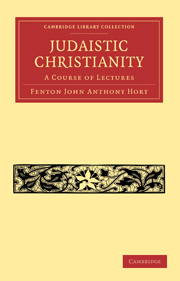Book contents
- Frontmatter
- PREFACE
- Contents
- I INTRODUCTORY LECTURE
- II CHRIST AND THE LAW
- III THE EARLY CHURCH AT JERUSALEM
- IV THE CHURCH OF ANTIOCH
- V THE INDEPENDENT ACTIVITY OF ST PAUL
- VI ST PAUL AT JERUSALEM AND THE EPISTLES OF THE ROMAN CAPTIVITY
- VII THE PASTORAL EPISTLES
- VIII JAMES, I PETER, HEBREWS, APOCALYPSE
- IX THE CHURCH OF JERUSALEM FROM TITUS TO HADRIAN
- X THE JUDAIZERS OF THE IGNATIAN EPISTLES
- XI CERINTHUS, ‘BARNABAS,’ JUSTIN MARTYR
- XII PALESTINIAN EBIONITES
- APPENDIX
- INDEX
VII - THE PASTORAL EPISTLES
Published online by Cambridge University Press: 07 September 2011
- Frontmatter
- PREFACE
- Contents
- I INTRODUCTORY LECTURE
- II CHRIST AND THE LAW
- III THE EARLY CHURCH AT JERUSALEM
- IV THE CHURCH OF ANTIOCH
- V THE INDEPENDENT ACTIVITY OF ST PAUL
- VI ST PAUL AT JERUSALEM AND THE EPISTLES OF THE ROMAN CAPTIVITY
- VII THE PASTORAL EPISTLES
- VIII JAMES, I PETER, HEBREWS, APOCALYPSE
- IX THE CHURCH OF JERUSALEM FROM TITUS TO HADRIAN
- X THE JUDAIZERS OF THE IGNATIAN EPISTLES
- XI CERINTHUS, ‘BARNABAS,’ JUSTIN MARTYR
- XII PALESTINIAN EBIONITES
- APPENDIX
- INDEX
Summary
The question of genuineness
We come now to the Pastoral Epistles. On the critical question of their genuineness I must say very little. The case of the Pastoral Epistles is by no means like that of other Epistles of St Paul which have been pronounced by critics to come from another hand on grounds which it is difficult to discuss seriously. There are features of the Pastoral Epistles which legitimately provoke suspicion. To the best of my belief, however, they are genuine, and that not merely in parts: the theory of large early interpolations does not work out at all well in detail.
Some groundless objections
While they present some difficulties which still await explanation, there is, I think, no real force in some of the objections which have been most strongly felt. Thus, (1) it is true that the Pastoral Epistles imply a period of activity in St Paul's life of which we have no other evidence: but neither is there any evidence against it, our ignorance being here complete. (2) The ecclesiastical arrangements are said to be the fiction of a later time: but this is mainly owing to misunderstanding of the ecclesiastical arrangements really implied; partly also to arbitrary assumptions as to the date of institutions. (3) The doctrines condemned are said to belong to no earlier time than the Second Century; but this, as we shall see, is due to a misunderstanding of what the doctrines really are.
- Type
- Chapter
- Information
- Judaistic ChristianityA Course of Lectures, pp. 130 - 146Publisher: Cambridge University PressPrint publication year: 2009First published in: 1894

